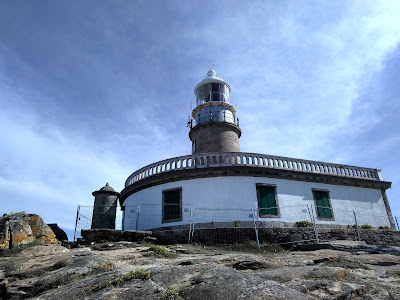The Dystopian Times, 11. A Morning of Peace
This morning, I had some time, so, I went to do an errand, and then I went for a drive out to the coast, all the way to the lighthouse at Corrubedo.
We've been out there many times. It's one of the most westerly lighthouses in Spain, and there is nothing beyond but the enormous expanse of the Atlantic Ocean. On a clear night, you can see the beacon from the lighthouse at Fisterra to the north, and from the Cíes Islands to the south, and the blackness that stretches west to the Americas.
In the summer, like this morning, the waves break with foam at the foot of the cliff the lighthouse is on, and run onto the beaches nearby with white rollers. The wind is gentle but firmly continuous. But, in the winter, especially after a storm, the spray from the waves smashing and thundering below reaches the lighthouse, and there is a perpetual dampness of the sea. The wind howls and threatens to knock you down and send you rolling along, like tumbleweed. The shape of the lighthouse, square toward land, and round to the sea, was deliberately designed like that so as to better withstand the winter winds.
It was built in the middle of the nineteenth century, and started working in 1854. With the change in centuries, new technology replaced old, but the light remained white, just as the lighthouse further south at the entrance to the estuary of Arousa, on Isle of Sálvora, which ended up confusing mariners. So much, that the vapor, Santa Isabel, ran aground in 1921 near Sálvora, thinking it was Corrubedo.
The vapor, a boat carrying mail and passengers between Bilbao and Fernando Poo, with a stop in Vilagarcía de Arousa, ran aground with well over 250 people on board. (Fernando Poo is now Malabo in Ecuatorial Guinea.) It happened on a December night, close to the new year, and most men were on the mainland, leaving mostly women and children behind on the small island. One woman took a boat to the mainland, to sound the alarm, since the ship could not send out any radio signal. Three other women took the remaining boat, and tried to save as many people as possible.
The three women were Cipriana Oujo Maneiro, 25; Josefa Parada, 16; and María Fernández Oujo, 14. Together, without knowing much about the sea and boats, they went back and forth until they rescued forty-eight people. Two hundred thirteen died. The women were later given money and medals, but scant recognition, and their story almost died with them. However, some historians did research their story, and now a film has been made, mixing fiction with truth, recounting that night and how the women were later treated. It's called La Isla de las Mentiras. (The Island of Lies)
Now, Sálvora is empty, the last houses of the islanders falling into time. After that shipwreck and yet another one, the light at Corrubedo was changed to red, so that mariners would distinguish it from the one at Sálvora. That change in color ended up giving the lighthouse the nickname, the Communist Light.
Now, the buildings are fenced off. The newer lighthouse keeper's house, which I remember still inhabited, with double windows, and geraniums on the inside sills, has had its windows bricked over. The light works, but remotely, by computer. A promoter bought the rights to the complex, and wanted to turn the buildings into a luxury hotel and four star restaurant. Permission was granted early last year, with a license to the promotor for twenty-five years. But work hasn't been started, yet, and the devil virus is making hotel developers think twice. And the lighthouse continues looking into the far west, warning ships.
I would have preferred a museum. There is a small museum at the lighthouse in Cabo Vilán, but the potential in Corrubedo is much bigger. The lighthouse could house different material, and provide a historical guide to both that particular lighthouse, and lighthouses in the Peninsula, in general. Both the old light keeper's house, and the newer one, could have exhibits on what it was like to live there, alone, all year, and one house could have the furniture and entertainments the keeper would have had. But, of couse, that would mean mostly public money. And no one wants to spend money without seeing a good return, which a museum certainly would not bring.
It was a lovely morning. When I arrived, there were two vans used as campers and a car or two. Not many people were about, and I didn't bother with a mask. As I was coming up from the area of the rocks, more cars had arrived, including one which parked next to mine, and the people in it were talking a correct Castilian Spanish, from the center of the Peninsula. It was time to go. I might return, again, next month, with fewer people. Unless we get quarantined, again.
Life continues.



Comments
Post a Comment